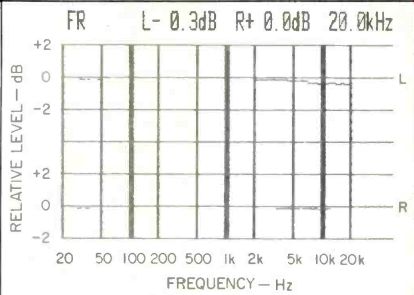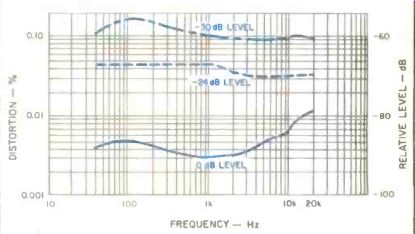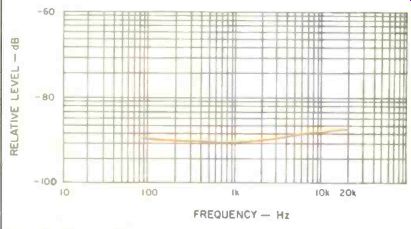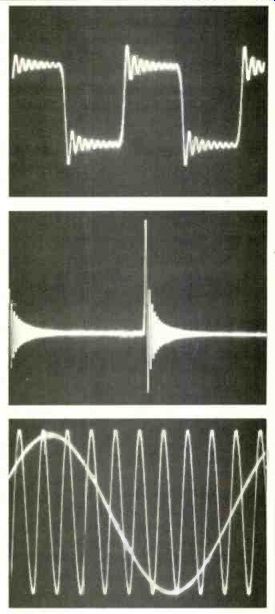
Manufacturer's Specifications
Frequency Response: 5 Hz to 20 kHz, ±0.5 dB.
S/N Ratio: 95 dB.
Dynamic Range: 95 dB.
Separation: 94 dB at 1 kHz.
Harmonic Distortion: 0.003% at 1 kHz.
Output Level: 2.5 V.
Number of Programmable Selections: 15.
Power Consumption: 23 watts.
Dimensions: 17 1/8 in. (43.5 cm) W x 4-5/16 in. (11 cm) H x 10 3/8 in. (26.4 cm) D.
Weight: 13 lbs. (5.9 kg).
Price: $1,000.00.
Company Address: 401 West Artesia Blvd., Compton, Cal. 90220.
Let me begin by stating in no uncertain terms that the DA 800 is vastly superior in its performance and features to the first-generation CD player, the DA-1000, offered by Hitachi more than a year ago. The earlier model, one of the first players I tested, proved to be so erratic that I had to ask for a second sample to obtain satisfactory readings and reliable performance. Clearly, Hitachi has learned a great deal about CD players since that first attempt. The DA -800, selling for no more than the earlier model, is a completely redesigned and reconfigured machine which performed perfectly during all my bench and listening tests. Furthermore, its special features, and the ease with which even a novice can make it perform all of its various functions, make it a CD player well worth considering.

The DA-800 allows you to select disc tracks you wish to hear and to play them in any random order. You can, of course, also begin play at any track number or even at a specific index point within a program track, if the particular disc is divided into indexed sections. Repeat play of a track, the entire disc, or even a given portion or musical phrase is easily accomplished. Up to 15 tracks can be pre-programmed for random sequence playing, and access time from track to track is extremely fast, usually no more than 2 or 3 seconds.
Control Layout
The front panel is finished in black. Discs are loaded into a motorized sliding drawer which opens smoothly when the "Open/Close" button is touched. A power button is located at the lower left of the unit, below the disc drawer. A display area to the right of the drawer indicates the number of tracks contained on a disc and its total playing time, after the disc has been inserted in the drawer and a brief scan of the contents has taken place. During play, the display shows track and index numbers, as well as time from the beginning of a track. Touch buttons below this display are "FB" (fast reverse), "Play," "FF" (fast forward), 'Pause," and "Stop/ Clear." If either of the fast -motion buttons is depressed along with "Play," the laser pickup moves either to the next track or to the beginning of the track currently being played.
If either fast-motion button is pressed by itself, accelerated laser-pickup scanning of the disc (in jumps of about 8 to 10 seconds worth of playing time) occurs.
To the right of the track and time displays is a display which tells the status of repeat -play functions. By touching the "Repeat" button below this display, you mark the beginning of a musical phrase you want repeated. Touching the "Repeat" button a second time marks the end of the phrase to be repeated, and repeat -play starts. It will continue until you touch the "Repeat" button a third time, thereby cancelling the preceding commands. "Repeat" is flanked by a "Program" button (to enter your track and index selections during programming) and by a "Call" button which allows you to review your programming sequence by calling up the selected track and index numbers in the main display. Ten small square buttons numbered from 0 to 9 are arranged in a horizontal row below the "Program," "Repeat" and "Call" buttons and are used to punch in desired program numbers. A stereo headphone jack and an output-level control are located at the extreme right end of the front panel. The output-level control alters signal levels at main output jacks as well as at the headphone output.
In addition to the usual left and right output jacks found on the rear panel, there is a slide switch labeled "Anti-Shock." The owner's manual explains that this switch should be placed in the on position when the player is located where it may be subjected to large amounts of vibration. The manual points out, however, that when this switch is on, sound "skipping" or muting may occur more frequently if a scratched or damaged disc is played.

Fig. 1--Frequency response, left (top) and right channels, at 0 -dB level.

Fig. 2--THD vs. frequency at levels of (from top to bottom) -30, -24, and 0
dB.

Fig. 3--Separation vs. frequency (both channels identical).
Measurements
Figure 1 is a plot of frequency response for both channels of the Hitachi DA -800 player. At 20 kHz, left-channel output was down by 0.3 dB, while right-channel output remained absolutely flat. This minor difference in response is probably attributable to tolerance variations in the analog low-pass filters which follow digital-to-analog conversion.
Figure 2 shows three plots of harmonic distortion versus frequency, at levels corresponding to maximum output (0 dB), -24 dB below maximum, and -30 dB below maximum. THD for maximum output, at mid -frequencies, was 0.0035%, rising to a still insignificant 0.013% at 20 kHz and 0.0045% at 41 Hz, the lowest frequency available for checking THD on my Philips test disc. SMPTE-IM distortion measured 0.003% at maximum output level, rising to 0.025% at a -20 dB output level.
Output linearity was accurate to within 0.2 dB from maximum output level all the way down to 80 dB. Below that point, my instrumentation is not accurate enough to verify precise linearity discrepancies, if any did indeed exist. Signal-to-noise ratio measured 96 dB, unweighted, increasing to 102 dB when an A-weighting network was introduced in the measurement path.
Channel separation, plotted in Fig. 3, measured 90 dB et mid-frequencies, decreasing to 87.5 dB at the high end of the spectrum. Separation was identical whether measured from left to right channel or in the reverse direction.
Examination of a reproduced 1-kHz square wave (Fig. 4) reveals that the Hitachi DA-800 CD player uses post-D/A, sharp cutoff filtering similar to that employed by Sony (and several other manufacturers), as opposed to the digital filtering and oversampling techniques used by Philips (and several other makers of CD players). The appearance of the recovered unit -pulse signal (Fig. 5) confirms that this circuit approach has been used. As has been true with all CD players that employ this filtering technique, some phase nonlinearity can be seen in the reproduced two-tone test signal shown in Fig. 6. Ideally, the lower frequency sine wave signal (2 kHz) should cross the zero axis in a positive going direction at the same instant of time that the higher frequency signal (20 kHz) crosses the zero axis in a positive direction. As you can see from examining Fig. 5, that is not quite the case for the Hitachi player. The error seems very minor at first-almost unmeasurable in terms of microseconds of time delay. Most of the players that utilize multi -pole, brick -wall analog filtering show greater phase errors on this test. But, as I have come to realize since making my tests for this report, this "improvement" may be an illusion, and the actual phase error could well be closer to some multiple of 360° than it apparently is to 0°. The Philips test disc containing musical selections and simulated scratches, dust specks, and fingerprint smudges was used to evaluate error -correction capabilities of the DA 800. In contrast to the poor tracking characteristics of the earlier Hitachi model checked a year ago, the DA -800 exhibited one of the best error -correction systems I have tested to date. Quite simply, the player was able to "track" all levels of the impairments deliberately applied to this disc: It was able to successfully correct missing data up to 900 microns wide in the case of the simulated scratch and up to 700 microns wide in the case of simulated dirt or dust particles on the surface of the test disc. No difficulty was encountered in playing through the simulated fingerprint smudge, either.

Fig. 4--Response to 1-kHz square wave.
Fig. 5--Single-pulse reproduction.
Fig. 6--Two-tone phase check (2 kHz left, 20 kHz right).
Use and Listening Tests
The Hitachi DA -800 has been performing perfectly in my lab for the past month. All of its operating features, including the various programming features, are easy to implement and work well. I have always favored the drawer -loading approach to disc insertion, if only for the reason that you can grasp the disc by its edges, never touching any portion of its surface. That's sometimes impossible to do with the swing-out or swing-down door system used on some other players.
Another feature of this player that particularly appeals to me is the front -panel level control. Only a few players I have tested have any sort of output -level control, and those are usually found on the rear panel, making them all but inaccessible if the player is installed in a shelf or cabinet. I find (and you will too) that voltage levels delivered by CD players are well above those normally produced by tuners, tape decks, or phono cartridges (after preamplification). Without a level control, this means that when you switch from one of these other program sources to CD, you have :o reach for your amplifier's master gain control. Usually, that control ends up at so low a setting that it is difficult to get fine gradations of volume -level adjustment. With a handy, front panel output -level control such as the DA -800's, you can set up output level so that loudness levels remain the same when you switch back and forth between CDs and other program sources.
The best aspect of this newest Hitachi CD entry was its sound quality. Here is a CD player that uses filtration which some critics claim "must" sound brittle and strident, and yet I heard no such sound. Rather. playing some of my most recently acquired discs, I was totally delighted with the sound quality delivered by the DA-800. I could listen to it for hours on end, thoroughly immersed in the music and completely oblivious of any of the so-called defects that some claim are inherent in the CD system. As far as I am concerned, Hitachi has come up with a real winner of a CD player this time.
-Leonard Feldman
(Audio magazine, May 1984)
Also see:
Hitachi DA-600 Compact Disc Player (Equip. Profile, Feb. 1985)
Hitachi DA-1000 Digital Audio Disc Player (Jan. 1983)
Hitachi Model SR-2004 Stereo AM/FM Receiver (Nov. 1978)
Digital Domain -- Keeping Your Distance (Feb. 1985)
= = = =